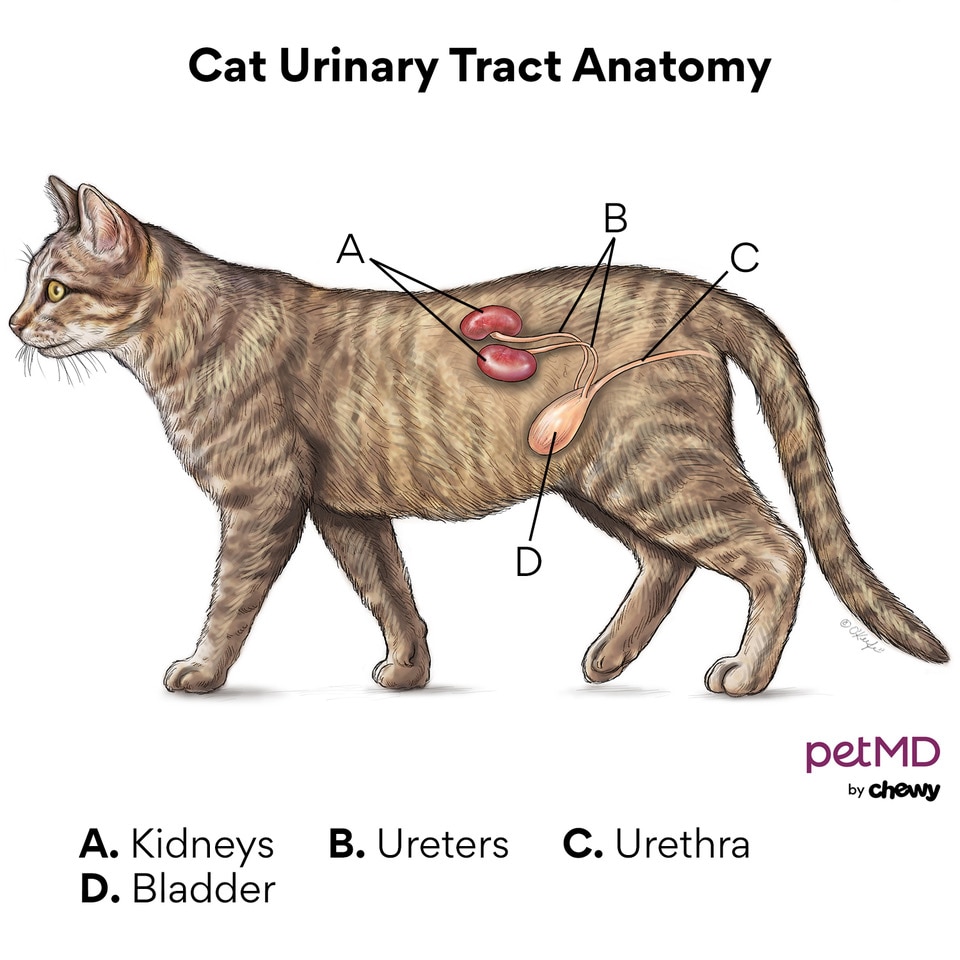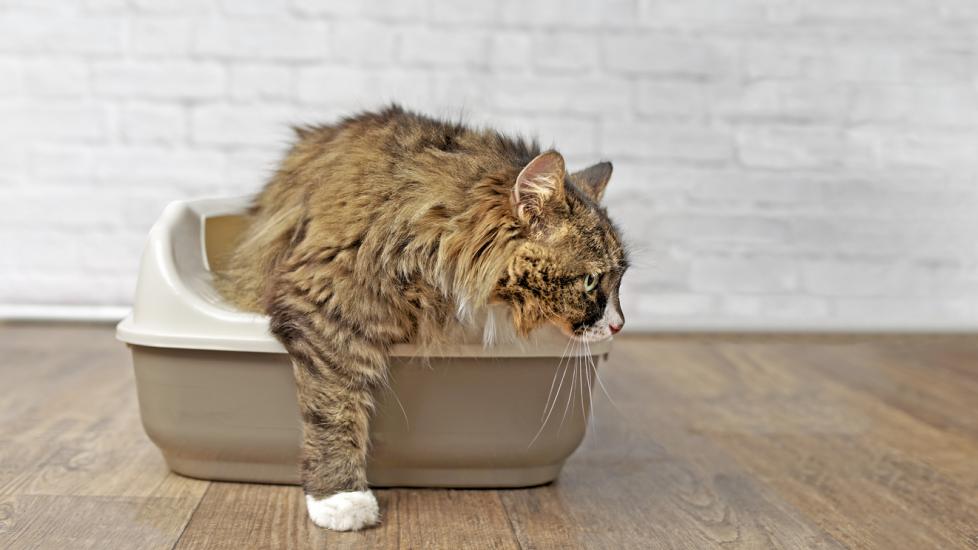Feline Lower Urinary Tract Disease (FLUTD)
iStock/Lightspruch
Your cat’s lower urinary tract disease (UTD) can cause them significant pain and discomfort.
If it causes obstruction, it can even be life-threatening. Here, we’ll cover what FLUTD is, its symptoms, how the vet diagnoses it, and treatments for a FLUTD cat.
Key Takeaways
- FLUTD is a group of conditions affecting a cat’s bladder and urethra, often causing pain, frequent urination, or urinating outside the litter box.
- Stress, urinary tract infections, bladder stones, and idiopathic cystitis are common causes of FLUTD, with male cats more prone to dangerous urethral blockages.
- Treatment and management depend on the cause, but may include diet changes, stress reduction, medications, or surgery in severe cases.
What Is Feline Lower Urinary Tract Disease?
Feline lower urinary tract disease (FLUTD) is a term that refers to several conditions affecting a cat’s lower urinary tract, including the bladder and the urethra (a thin tube that carries urine from the body to the external genitals).
Feline lower urinary tract disease can be frustrating for both pet parents and veterinarians because the underlying cause can be difficult to identify, and the illness can range in severity.

Click here to download this medical illustration.
Most cases of feline lower urinary tract disease can be managed with a combination of medications, diet, and environmental changes.
Feline lower urinary tract disease can occur in cats at any age, depending on the underlying cause.
It’s most often seen in young to middle-aged adult cats. However, it has been diagnosed in kittens and even senior cats who have never shown urinary symptoms.
Types of Feline Lower Urinary Tract Disease
Currently, feline lower urinary tract disease is used as an umbrella term to describe the clinical signs of a few syndromes that can occur on their own or in combination.
Some of the conditions that can cause FLUTD include:
-
Urethral obstruction
Most causes of FLUTD will be caused by the conditions listed above. Less commonly, FLUTD can occur due to cancer (bladder or urethra), structural abnormalities in the urinary tract, injuries, or neurologic issues.
Symptoms of Feline Lower Urinary Tract Disease
The most common symptom of FLUTD is your cat urinating outside the litter box.
Inappropriate urination often occurs on clothes, bedding, and rugs. Some cats may choose one location, but others may urinate throughout the home.
Your cat may also make very frequent trips to the litter box but only pee small amounts at a time. Other symptoms include vocalizing while urinating and/or the presence of blood in the urine.
If you see your cat trying to use the litter box and producing no urine at all, or just a few small drops, bring them to the vet immediately.
This may be a sign of the most severe FLUTD syndrome—urethral obstruction. This occurs more commonly in male cats but can occur in females as well.
Health Tools
Get quick answers with our vet-created Symptom Checker
Causes of Feline Lower Urinary Tract Disease
Because FLUTD is an umbrella term for lower urinary tract diseases in cats, anything that can cause any of the potential “types” of FLUTD is a potential cause.
-
Urinary tract infections
-
Bladder stones
-
Urethral obstruction: urethral plugs, stones, tumors
-
Feline idiopathic cystitis (underlying cause not definitively known but chronic anxiety thought to play a major role)
-
Tumors in the urinary tract
-
Anatomical abnormalities
-
Injuries/trauma
-
Spinal cord injuries causing neurologic conditions
How Vets Diagnose FLUTD
Diagnosis of FLUTD can be tricky and often relies on a combination of a physical exam, test results, and patient history.
Your vet will perform a urinalysis to rule out a UTI. Some cases may require a urine culture if the infection is hard to find or does not respond to initial antibiotics.
You vet may also perform blood work to look for systemic (whole body) infection, diabetes, and kidney disease.
These conditions may have similar symptoms to FLUTD.
Stones in the bladder or urethra can usually be found on X-rays, though ultrasounds may be preferred when looking for kidney changes or bladder abnormalities that wouldn’t show up on X-rays.
Successful diagnosis and treatment of FLUTD often requires a lot of information about how a cat interacts with their environment at home.
Recent behavior changes in your cat are an important part of the diagnosis. You may be asked to complete a detailed questionnaire about how and where your cat eats, sleeps, plays, and interacts with family members, as well as any recent changes to your cat’s environment.
These questionnaires can be just as helpful as regular lab tests because they can help identify stressors in your cat’s environment.
Treatment for FLUTD
Treatment of FLUTD is very individual and based on the specific syndrome. Some common treatments include increasing water consumption (feeding wet food or offering a water fountain), giving your cat more litter box options, and weight loss in overweight cats.
Some cats require a combination of therapies or a “multimodal” approach.
Here are some more specific treatments your vet may use based on the underlying cause:
-
Antibiotics for UTIs (most common first choice is amoxicillin)
-
Surgery or veterinary diets for bladder stones
-
Pain medications, veterinary diets, anti-spasmodic medications, and stress management for FIC.
-
Short-term medications like buprenorphine (opioid) and prazosin (anti-spasmodic) may be used during the initial episode.
-
-
For stress management, you can use pheromone diffusers, food puzzles, cat trees, and water fountains to reduce stress and promote your cat’s happiness.
Extreme cases may require anti-anxiety medications, but these are often a last resort.
Recovery and Management of FLUTD
Though improvement of symptoms can occur within days, it’s common for FLUTD to come back, so active management will be a lifelong commitment for a pet parent.
Anti-anxiety medications like fluoxetine or sertraline may only be used long-term in severe cases.
These medications can take over a month to take effect. In the interim, your cat may take short-acting anti-anxiety medications like gabapentin, Cats that respond well to veterinary diets should stay on them indefinitely. You will work with your veterinarian to adjust treatment accordingly.
Sudden changes in your cat’s environment make it much more likely for symptoms to return. You will need to try to anticipate stressful situations for your cat, such as moving or adding new pets or family members to the household.
While many cats with FLUTD can live a long and happy life, it’s not uncommon for treatment to fail. For male cats with recurrent obstruction, a surgery to create a new urethral opening in the perineum (perineal urethrostomy) may be recommended.
Unfortunately, humane euthanasia may be considered for cats with pain that can’t be controlled.
FLUTD (Feline Lower Urinary Tract Disease) FAQs
Is there a cure for FLUTD in cats?
Whether there is a “cure” for FLUTD depends on the cause of the disease.
For most cats with FLUTD, who experience idiopathic cystitis or urethral obstruction, the exact cause is unknown and supportive care is needed to prevent recurrence.
However, if the cat has bladder stones or a urinary tract infection, the individual incident may be curable.
How long can a cat live with FLUTD?
Your cat will have a normal lifespan if the disease can be managed well.
For cats with recurrent episodes of FLUTD, especially urethral obstruction, quality-of-life decisions may be necessary.
How do I know if my cat has FLUTD?
Cats with FLUTD show any or all the following clinical signs: urinating outside the litter box, visiting the litter box frequently, straining to urinate, and blood in the urine.
Male cats with severe complications may exhibit vomiting, decrease in appetite, and/or hiding—sometimes, with no known urinary symptoms.
How long does it take for FLUTD to go away?
The time frame depends on the specific type of FLUTD. Urinary infections may clear up in a few days, while FIC may take weeks to months to manage appropriately.
What do you feed a cat with FLUTD?
There are multiple prescription diets available to help manage FLUTD in cats.
These diets are created to increase water intake, change the pH of the urine, reduce the risk of bladder stones, and even help with behavioral management.
For situations where a prescription diet is not practical, cats with FLUTD benefit from a diet based on canned food to help increase water intake.
